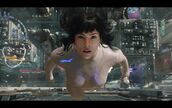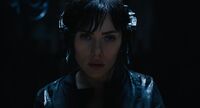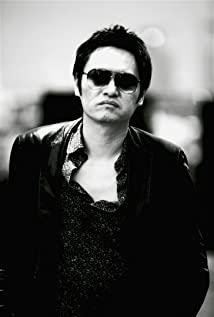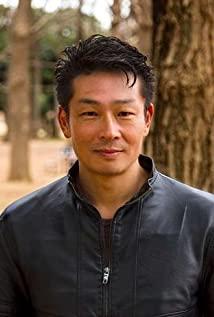Scarlett Johansson is so beautiful; her face is so perfect from any angle, and there is still a look of arrogance between her brows. The fly in the ointment, the flesh-colored tights that seemed to be naked but not naked, looked a bit embarrassing, and I couldn't bear to look directly at them. The footage of the film is dazzling, but unfortunately, all the scenes and bridges that can impress you are all reproduced from the animation of Oshii Mamoru. It can be said that the success of this film comes from the heroine's personal charm and Oshii Mori's aesthetics. And the part where the film failed came from Hollywood's vulgar modification of the original.
Sure enough, it is the standard of Hollywood blockbusters; there are scenes, there are stars, and then, with a little bit of thinking, they live together. The original is a typical cyberpunk work, and the live-action version is too unpunk. But I'm not as frustrated as the original party. How can I expect anything? It must be like this, right? The director wasn't Ridley Scott.
Japanese animation masters like Mamoru Oshii can no longer simply be evaluated as craftsmen; they are making art. The original author of the work is Masamune Shirou, and there is also a TV version of the animation. The setting of the world view and philosophical thinking have already begun. However, this story reached its peak in the hands of Oshii Mamoru. It feels like Masamune Shirou wrote "Water Margin," and then Mamoru Oshii drew a short paragraph from it to create "Plum in the Golden Vase."
"Ghost in the Shell" describes a future that historian Yuval Harari worries about: With the development of technology, artificial intelligence will take over the work of human beings completely, and human beings will be divided into two parts, each in charge of artificial intelligence. The God-man is on high, and everyone else is trash. The gods can live forever through technology and waste. Who will care about the waste?
Kusanagi Motoko is such a "Godman", and her identity is also called "Yoshiti Man" by a more "equal" This is the world view designed by "Ghost in the Shell". In the future world, everyone's body can be replaced by a prosthetic body, and everyone's brain can be connected to the Internet, of course, provided that you have money. On the other hand, since it is connected to the Internet, it is possible to be attacked by hackers, and future cyber crimes will directly invade the human brain. The Nine Section of the Public Security where Motoko works is the mobile unit that fights cybercrime.
The word "attack in the shell" refers to the "attack-type reinforced armor shell", which is the combat-type prosthesis of Motoko. What this prosthetic body carries is Motoko's brain, which is the only part of her that still belongs to human beings. It can be said that it is the soul of her body. The English translation of this film is Ghost In The Shell: The Soul In The Shell. In the cartoon, Motoko says to his partner Bart: "Probably all biochemical people with full-body prosthetics will have the same confusion." Maybe he died a long time ago, and now I am just a virtual body composed of prosthetics and an electronic brain. " Perhaps the true 'I' never existed at all... After all, my existence is only based on the surrounding situation to make corresponding judgments.
Suzi's confusion can be regarded as the eternal confusion of human beings. Who am I? What defines me? Is the world I perceive real? If the body defines a person, then if the body is replaced, is a person still a person? If the soul defines man, then if the soul is tampered with, am I still me? In turn, these series of questions are also questions for robots. If the soul is the essence of human beings, and when artificial intelligence has self-awareness, can it be considered human? Is it life? Is it life? Is it life? Is it life? Is it life? Is it life? Is it life? Just like the puppet master in the animated version, born from a touch of consciousness in the ocean of the Internet, is it life?
Regarding the issue of human identity, the most famous thought experiment is the "Ship of Theseus". This is a paradox. Assuming that the elements that make up an object are constantly replaced, is it still the original object? This ancient fable was first recorded by Plutarch in the first century AD. Be lazy and copy the introduction from Baidu Encyclopedia: It describes a ship that can sail at sea for hundreds of years thanks to non-stop repairs and replacement parts. As soon as a board rots, it is replaced, and so on, until all the functional parts are no longer what they were originally. The question is, is the resulting ship still the original Theseus ship, or a completely different ship? If it's not the original ship, at what point does it cease to be the original ship? Hobbes later extended this: if a new ship was built using old parts from the ship of Theseus, which of the two ships was the true ship of Theseus?
I once read a tragic sci-fi story in which an astronaut wandered to a strange planet and waited for rescue, similar to a mine accident in which someone was crushed underground and had no food. He has a machine by his side that can quickly create clones, so he plans to use his clones for food. However, there is a problem. That is, his clone has all his memories from birth, including the memory of cannibalism, so it is a fight to come out, and the living eat the dead. After many days, the rescue team came. At this time, the astronaut no longer knew whether he was still his original self.
The confusion of the astronauts is also the confusion of Motoko. Some people may say that the only constant is the soul, and the soul is in me. It may be necessary to interject that the soul we are discussing is definitely not the kind of existence in religion that can float around alone after death. (It may be regarded as human consciousness.) So what is a soul? Like astronauts and Motoko, is a collection of memories that can be transferred to different shells counted as souls? If this is the soul, why bother with astronauts eating flesh?
In other words, the soul is not only memory but also includes a series of elements such as a person's cognition, thinking, emotions, etc. Just copying memories is not a complete person. However, don't forget that these elements depend on the body to exist, and the hair will not be attached to the skin. So, to an astronaut, even a fully replicated clone is another person. And, in the future, when we can transform the body at the genetic level, how can we be certain that the soul or consciousness has not been tampered with or deceived?
This is reminiscent of another thought experiment: the brain in a vat. This is the hypothesis expounded by Hilary Putnam in his 1981 book Reason, Truth, and History. Continue Wikipedia "A man (presumably yourself) was operated on by evil scientists. His brain was cut from his body and placed in a tank of nutrients that kept the brain alive. The brain's nerve endings were connected to a computer. This computer sends information to the brain according to the program, so that he maintains the illusion that everything is completely normal. To him, it seems that people, objects, and the sky still exist, and their own movements and physical sensations can be input. This brain can also The memory is entered or intercepted (the memory of brain surgery is intercepted, and then the various environments he may have experienced in daily life.) He can even be entered into codes, 'feeling' that he is reading an interesting and absurd text here. The most basic question about this hypothesis is: "How can you guarantee that you are not in this predicament?"
The movie "Resident Evil", which ended not long ago, threw a similar question. The heroine, Alice, always thought that she had lost her memory, and she didn't know until the end that she was just a clone, and only the memory she should have had was transplanted. Even if it cannot be said that Alice is not human by nature, she is obviously incomplete. The ending is quite bloody, and the object of Alice's clone copied all her memories onto her. But will having a complete memory solve the clone's identity crisis? Or find a good editor and cut the two memories seamlessly, cutting out the fact that Alice knew she was a clone, but wouldn't that still be a deception?
Of course, in "Resident Evil" or the live-action version of "Ghost in the Shell", the so-called philosophical thinking is just a gimmick, which makes the film look like a cool core, and the focus is on the beautiful heroine fighting monsters. But for Oshii Mamoru, stories are just material for thought. Different centers of gravity, or different abilities, make the former just a popcorn movie, while the latter, mixed with complex thinking about politics, philosophy, technology, and religion, has become a classic in cyberpunk movies.
so-called cyberpunk. If you don't ask me, I seem to know what it means, but when you ask me, I'm confused. It is preferable to examine the works directly rather than try to understand the cyberpunk style through text descriptions. "Ghost in the Shell" is, of course, a classic of cyberpunk, and so is "The Matrix", which draws inspiration from it. Even earlier, of course, James Cameron's "Terminator" and Ridley Scott's "Blade Runner." If you've seen these movies, you probably know what cyberpunk is. When it comes to "Blade Runner", it is impossible not to mention the original author, Philip Dick. Many of his works, such as "Minority Report" and "Total Recall," can be classified as cyberpunk. Dick said, "My main concern is: what is real?" I even question the existence of the universe. I'd like to know if it's true. I want to know if we are all real. "
We can see from these works that, as a branch of science fiction literature, cyberpunk-themed works are not the same as those sci-fi stories that take place in the distant future or outer space. Stories often take place in the not-too-distant future, and the location is, of course, the earth. Therefore, such works have a strong realistic appeal, giving readers and audiences a strong sense of substitution, so as to realize the creator's good intentions: if human technology develops like this, what awaits us will be a terrifying future world.
Scholar Gao Jun commented, "In reality, cyberpunk is a kind of counterculture, just as the characters it shapes are often anti-system anarchists, and its influence has always penetrated into the hacker subculture. Cyberpunk We believe that the decentralization and democratization of technology are the directions for the future of society. In short, technology should not be monopolized by the government or some companies. The popular open source and encryption cultures in the hacker community are based on this subcultural concept. Scholar Gao Jun commented, "In reality, cyberpunk is a kind of counterculture, just as the characters it shapes are often anti-system anarchists, and its influence has always penetrated into the hacker subculture. Cyberpunk We believe that the decentralization and democratization of technology are the directions for the future of society. In short, technology should not be monopolized by the government or some companies. The popular open source and encryption cultures in the hacker community are based on this subcultural concept. " Scholar Gao Jun commented, "In reality, cyberpunk is a kind of counterculture, just as the characters it shapes are often anti-system anarchists, and its influence has always penetrated into the hacker subculture. Cyberpunk We believe that the decentralization and democratization of technology are the directions for the future of society. In short, technology should not be monopolized by the government or some companies. The popular open source and encryption cultures in the hacker community are based on this subcultural concept. Scholar Gao Jun commented, "In reality, cyberpunk is a kind of counterculture, just as the characters it shapes are often anti-system anarchists, and its influence has always penetrated into the hacker subculture. Cyberpunk We believe that the decentralization and democratization of technology are the directions for the future of society. In short, technology should not be monopolized by the government or some companies. The popular open source and encryption cultures in the hacker community are based on this subcultural concept. " ( "Basic."
In fact, technological progress has brought general anxiety, and every electronic device in our hands seems to be alienating us a little bit into cyborgs (cyborgs). Smartphones are becoming our new organs. And the Internet connects us with each other, and each individual becomes a board member of the Internet, the ship of Theseus. And the biggest anxiety is that no one can guarantee that there will not be an old ship on board that has been replaced. Everyone has the potential to become a marginalized person in the cold technological world described by cyberpunk literature.
Looking back at the two cartoons by Mamoru Oshii ten or twenty years ago, they are more and more fables, just like the prophecy written by George Orwell about 1984. It may also be because of his reminder that history is not fully headed toward the terrifying future he describes. Today's world is more like Huxley's "Brave New World". So, will people walk into the cyberpunk future described in his works? Entering that extreme society where highly developed technology and the loss of life value are intertwined? Nobody knows.
But this reminder is crucial, and it warns us not to be so optimistic about technology. Scholar Whig said: "When a tradition is deeply embedded in culture and permeates all aspects of life, people who live in it tend to turn a blind eye to it; even if they know it, they take it for granted and therefore do not think it is worth talking about; only when something completely different and contrary to it happens within the field of vision, do people have the first opportunity to see the tradition that they have been practicing."
But despite seeing the mirror, the person outside the mirror is still questioning the authenticity of the image in the mirror. Because they are only pessimistic about the future, cyberpunk works can only be regarded as standard in subcultural circles. But it's as if you're running down the road and there's a bunch of kids in fancy clothes yelling, "Hey, be careful, there might be a trap ahead!" You may not stop because of this, but you will remember this reminder in your heart. Even if it turns out that there are no traps ahead, you won't have any doubts about the goodwill of those kids. At least they still look cool.
View more about Ghost in the Shell reviews











